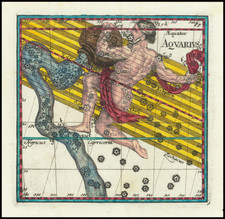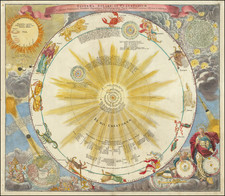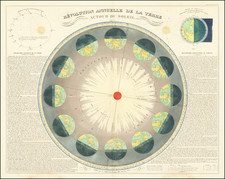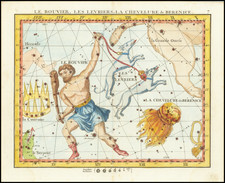A Magnificent Depiction of a Total Solar Eclipse. Made by the "Audubon of the Sky", Etienne Trouvelot.
This is a beautiful color lithograph showing an eclipse of the sun, made by Etienne Trouvelot and relating his observations made during the summer of 1878 in the Wyoming Territory. The chromolithograph was published as part of Trouvelot's Astronomical Drawings set of 15 plates by Charles Scribner's Sons in 1882.
Trouvelot's drawings are known as some of the best images of the sky ever made. Trouvelot's work was very important at the time, as it provided important images of the stars, planets, and phenomena of the sky at a time when popular interest in astronomy was growing, but photography had not yet become advanced enough to capture such dark images. Trouvelot's images are recognized as the last of the great images of the night sky that surpassed the photography of their day.
"Terrifying, appalling, and yet possess[ing] a majestic grandeur and fascination" -- the 1878 Solar Eclipse
The 1878 eclipse fascinated the American public and drew observers from all over the country, much like the 2017 eclipse which passed through the same region. Enthusiasts like Thomas Edison arrived to test out new devices, while astronomers prepared diligently for over a week to make sure that they would not miss the event. The U.S. Naval Observatory even set up a field observatory, complete with roof.
Solar eclipses have always captivated humanity due to the epic nature of their occurrence. By the 18th century, they were studied regularly, and in Trouvelot's time, they were fairly well understood. Particularly important is that, during an eclipse, certain features of the sun become more easily visible. In this image, we see both the corona (the white rays), which is the sun's atmosphere, and solar prominences (the red light to the right), which are jets and loops of plasma hundreds of thousands of miles long.
Trouvelot provides a useful description of the phenomena shown as follows in his Trouvelot Astronomical Drawings Manual:
A telescopic view of the sun’s corona or extreme outer atmosphere and of the solar flames or prominences during a total eclipse. At the moment of observation the dark disk of the moon, while still hiding the sun’s main body, had passed far enough eastward to allow the rosy pink chromospheric prominences to be seen on its western border. On all sides of the sun’s hidden disk, the corona shows its pale greenish light extending in halo-like rays and streamers, and two very remarkable wings stretch eastward and westward very nearly in the plane of the ecliptic and in the direction of the positions of Mercury and Venus respectively at the time of observation. The full extent of these wings could not be shown in the Plate without reducing its scale materially, since the westerly wing extended no less than twelve times the sun’s diameter, and the easterly wing nearly as far, or over ten million miles. A circlet of bright light immediately bordering the moon’s disk is the so-called inner corona, next to which the wings and streamers are brightest, thence shading off imperceptibly into the twilight sky of the eclipse. Other noteworthy peculiarities of the corona, as observed during this ellipse, are the varying angles at which the radiating streamers are seen to project, the comparatively dark intervals between them, and the curved, wisp-like projections seen upon the wings. An especially noticeable gap appears where the most westerly of the upward streamers abruptly cuts off the view of the long wing. The largest and brightest of the curving streamers on the westerly wing coincides with the highest flame-like protuberance. To some observers of this eclipse the upward and downward streamers seemed pointed at their outer extremities and less regular in form.
Rarity
Trouvelot's prints were originally intended for the astronomical and scientific community and most of the larger US observatories purchased copies of the portfolio. In 2002, B.G. Corbin undertook a census to determine the number of surviving copies of the complete set of 15 prints and was only able to confirm the existence of 4 complete sets.
Trouvelot (1827-1895) was born in Guyencourt, Aisne, France. During his early years he was apparently involved in politics and had Republican leanings. Following a coup d'état by Louis Napoleon in 1852, he fled or was exiled with his family to the United States, arriving in 1855. They settled in the town of Medford, Massachusetts, where he worked as an artist and nature illustrator. In both 1860 and '70 census, his occupation is listed as lithographer.
Trouvelot had an interest as an amateur entomologist. In the U.S., silk-producing moths were being killed off by various diseases. Trouvelot brought some Gypsy Moth egg masses from Europe in late 1866 and was raising gypsy moth larvae in the forest behind his house. Trouvelot apparently understood the danger posed by the Gypsy Moths and housed them under netting. Unfortunately, an egg mass went missing during a storm in 1869. He immediately realized the potential problem he had caused and notified some nearby entomologists, but nothing was done. This story has been called into question, based on earlier reports Trouvelot made that his netting had holes in it large enough for robins to fit through and eat his caterpillars.
Shortly following this incident, Trouvelot lost interest in entomology and turned to astronomy. In this field he could put his skills as an artist to good use by illustrating his observations. His interest in astronomy was apparently aroused in 1870 when he witnessed several auroras.
When Joseph Winlock, the director of Harvard College Observatory, saw the quality of his illustrations, he invited Trouvelot onto their staff in 1872. In 1875, he was invited to the U.S. Naval Observatory to use the 26-inch refractor for a year. During the course of his life he produced about 7,000 quality astronomical illustrations. 15 of his most superb pastel illustrations were published by Charles Scribner's Sons in 1881. He was particularly interested in the Sun, and discovered "veiled spots" in 1875. Besides his illustrations, he published about 50 scientific papers.
In 1878, Trouvelot and his son traveled to Creston, Wyoming Territory, to observe the total eclipse of the Sun on July 29.
By 1882, Trouvelot had returned to France and joined the Meudon Observatory. He worked there under Jules Janssen, a leading solar astronomer. However, Trouvelot resented the cloudy French sky, which impeded his observations. He traveled with Janssen to the Caroline Islands in the South Pacific to observe the total eclipse of 1883 and attempt to discover the phantom intra-Mercurial planet.
Trouvelot died at Meudon on April 22, 1895. At the time he was working on a monograph of Mars. His son, George, hoped to find a publisher for Etienne's drawings of Mars, but was unsuccessful. The whereabouts of almost all of the drawings left by Trouvelot to his family are currently unknown.









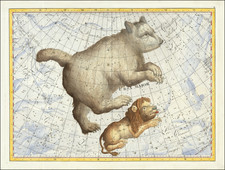
![[ The Ptolemaic Universe ] Situs Terrae Circulis Coelestibus Circundatae . . .](https://storage.googleapis.com/raremaps/img/small/101512.jpg)
